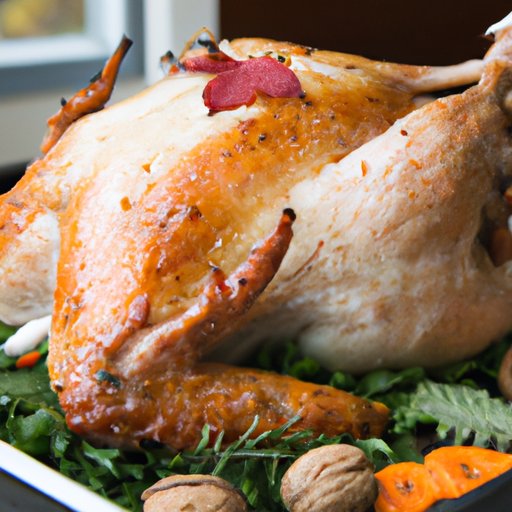I. Introduction
When we think of Thanksgiving, one of the first things that come to mind is turkey. But why do we eat turkey on this special day? In this article, we will delve into the origins, cultural significance, nutritional benefits, economic impact, and environmental considerations of serving turkey for Thanksgiving dinner. As we explore these topics, we hope to provide you with insights into why turkey has become such an integral part of American Thanksgiving tradition.

II. The Origins and History of Incorporating Turkey into Thanksgiving
Thanksgiving is one of the most celebrated holidays in the United States, dating back to the Pilgrims’ first harvest celebration with the Wampanoag tribe in 1621. It eventually became a national holiday in 1863, with President Abraham Lincoln’s proclamation. Early records show that turkey was not likely the centerpiece of this original feast, as accounts list deer, fish, and fowl among the menu items. However, it was in the 19th century that turkey became associated with Thanksgiving due to its abundance and affordability. Additionally, the bird’s large size made it the perfect choice for feeding a crowd.
Other foods commonly served on Thanksgiving include stuffing, mashed potatoes, cranberry sauce, green beans, and pumpkin pie. These foods have also become staples of the holiday and are deeply ingrained in American Thanksgiving tradition.
III. The Cultural Significance of Turkey in American Cuisine
Turkey has long been a part of American cuisine and culture. According to the National Turkey Federation, approximately 46 million turkeys are consumed in the U.S. during Thanksgiving alone. It is often served during other holiday gatherings and special occasions because of its abundance, versatility, and associated values of generosity, hospitality, and communal dining.
The bird has been referenced in literature, as well as popular culture. It’s featured in various films, TV shows, and holiday advertisements, further cementing its status as a quintessential symbol of Thanksgiving in modern American culture.
IV. The Nutritional Benefits of Turkey
Aside from being a staple of holiday traditions, turkey also provides several nutritional benefits. White turkey meat is a lean protein that is high in B vitamins, phosphorus, and potassium, all of which are crucial for maintaining a healthy diet. It is an excellent source of low-fat protein, which can help you feel satiated and energized. Moreover, turkey can be a healthier alternative to red meat, which can be high in cholesterol and saturated fats.
Aside from these nutrients, turkey is also known for its tryptophan content, which is believed to induce drowsiness. Contrary to popular belief, the levels of tryptophan in turkey are not any different than in most other foods. Tryptophan is an amino acid that helps create serotonin, a neurotransmitter that regulates mood, and melatonin, a hormone that regulates sleep. The reason you might feel sleepy after Thanksgiving dinner is likely due to large meals combined with alcohol consumption, not turkey specifically.
V. Comparison of Turkey with Other Meats Traditionally Served for Holidays in Other Cultures
While turkey is a staple for Thanksgivings in the United States, other cultures have their own traditional meats for special occasions. For example, in Europe, roasted goose has long been a Christmas favorite. In China, dumplings made of pork are a staple of Lunar New Year feasts, while in Latin America, roast pork, or lechon, is commonly served during Christmas celebrations.
When it comes to taste, turkey is a mild meat that can be seasoned to suit a variety of flavor profiles, while other meats typically have stronger, distinct flavors. Nutritionally, there can be variations in fat and calorie content, but lean cuts of turkey are similar to most other lean meats.
However, what sets turkey apart is its association with Thanksgiving, a holiday uniquely American in its origin and significance. Its symbolic weight elevates its value beyond the plate, making it an emblem of community, gratitude, and family.
VI. The Economic Impact of Turkey Consumption During the Holiday Season
The turkey industry plays an essential role in the U.S. economy, especially during the holiday season. According to the National Turkey Federation, turkey production generates around $29 billion in economic activity, creating tens of thousands of jobs across the country and supporting small, rural communities. Moreover, turkey sales make up a significant percentage of grocery retailers’ profits during the holidays, and holiday-related food sales, in general, represent a massive part of the $1.4 trillion retail food market in the United States.
VII. Creative and Delicious Turkey Recipes for Thanksgiving and its Versatility as Leftovers
Aside from roasting a whole turkey, there are various ways to prepare this versatile meat. Brining, smoking, grilling, and frying are some of the popular techniques to flavor and highlight its natural taste. For those who want to go beyond the traditional roast, incorporating spices and herbs like cinnamon, sage, thyme, and garlic can enhance its taste and aroma. Even the leftovers can be transformed into delicious soups, casseroles, and sandwiches.
One popular recipe for Thanksgiving leftovers is the turkey sandwich, featuring slices of roasted turkey, stuffing, cranberry sauce, and gravy, all layered in between slices of bread. Additionally, turkey can be a healthy alternative to processed meat and hot dogs, making it a versatile ingredient in everyday meals beyond Thanksgiving.
VIII. The Positive Environmental Impact of Choosing to Serve Sustainably-Raised and Sourced Turkeys
Many turkey farms operate with unsustainable practices that can harm the environment and diminish animal welfare. These practices include overuse of antibiotics, unsanitary living conditions, and polluted groundwater. Choosing to serve sustainably-raised and sourced turkeys can help support ethical farming practices and reduce environmental harm. Look for certifications like Certified Humane, Animal Welfare Approved, or Global Animal Partnership to ensure that your turkey comes from farms that follow strict animal welfare and environmental standards. Additionally, opting for locally-sourced turkeys can reduce the carbon footprint of transportation and support small, family-owned farms instead of large, industrialized ones.
IX. Conclusion
From its origins as a delectable culinary feature of the first Thanksgiving feast to its central role in American culture, turkey has become a treasured ingredient in our lives. It is a protein-packed, healthy, and versatile meat that can provide a centerpiece for special occasions, and leftovers that will last for days. Remember to enjoy your Thanksgiving turkey while also considering the ethical, environmental, and nutritional considerations that come with it.
